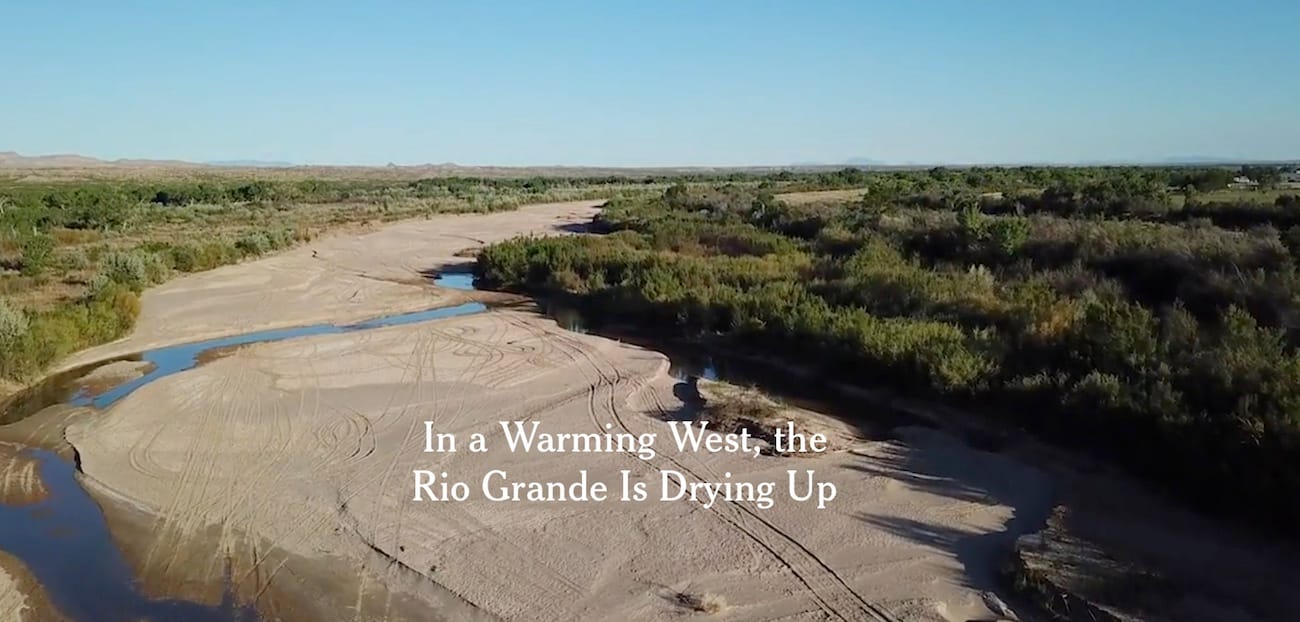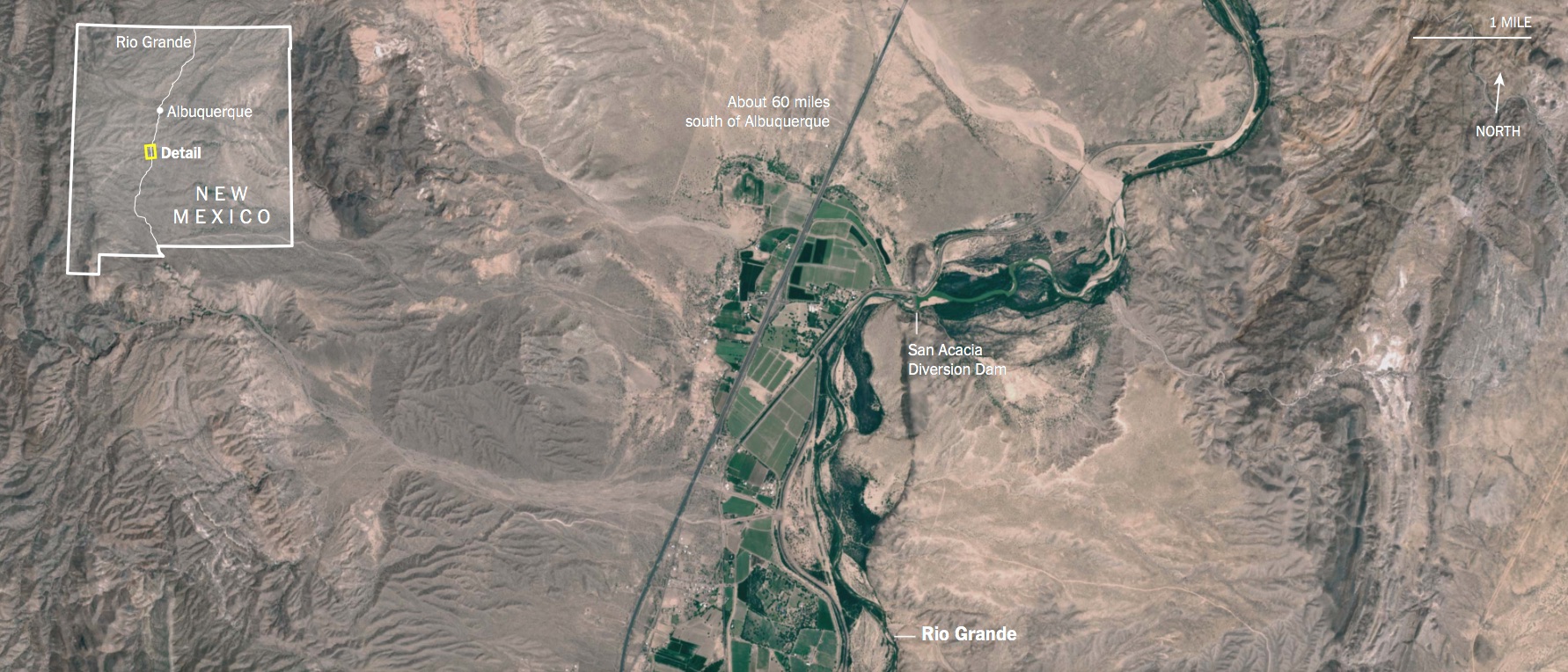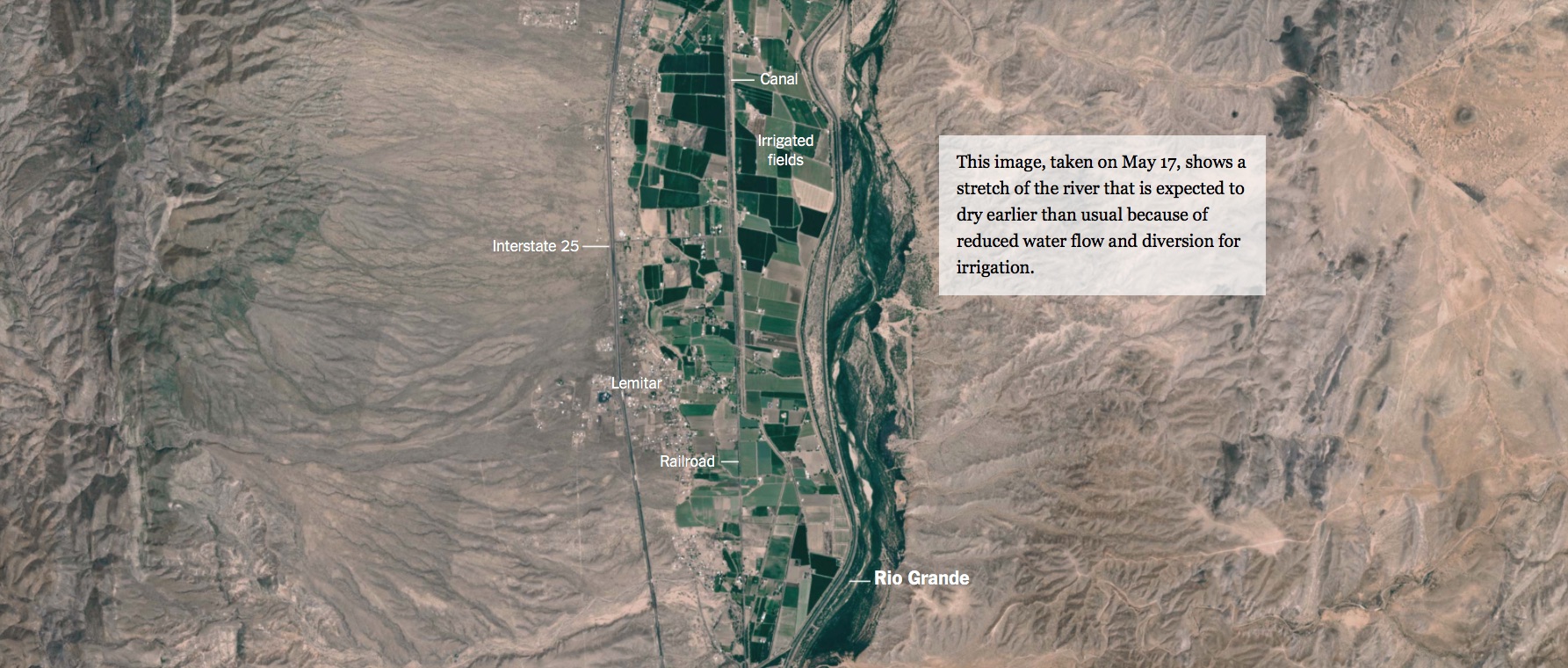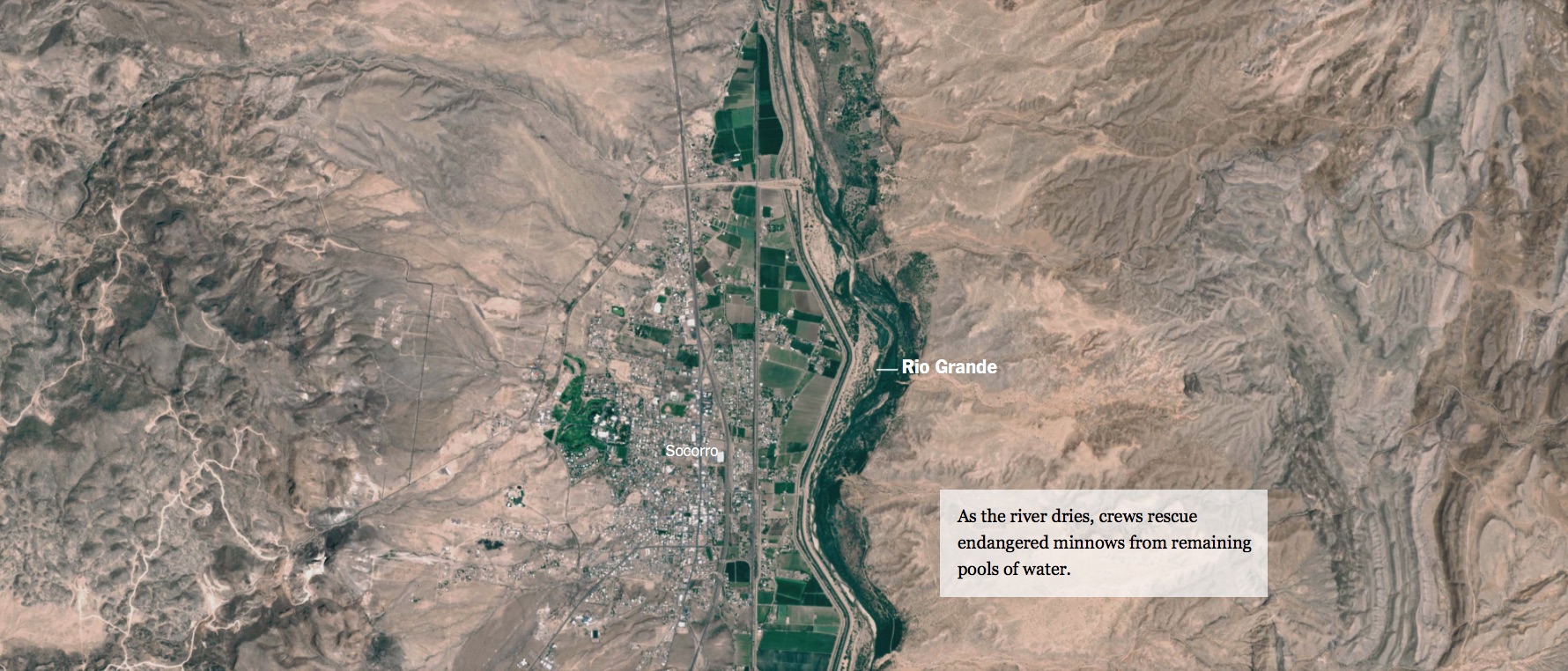In a Warming West, the Rio Grande Is Drying Up

Agency, university and other water ‘experts’ blame climate change for declining river flows. They ignore the primary influences on land and rivers: Irresponsible agricultural practices. It is a misuse of precious Southwestern desert water to irrigate low value crops – let alone subsidize this. And next, Industrial Agriculture’s farming methods rely on chemicals like Roundup, which destroy soil’s fertility and ability to hold water, increasing its need for irrigation.
NOTE: this article was originally published to the NYTimes.com on May 24, 2018. It was written by Henry Fountain and photographs and video are by Josh Haner.
Even in a good year, much of the Rio Grande is diverted for irrigation. But it’s only May, and the river is already turning to sand.
LEMITAR, N.M. — Mario Rosales, who farms 365 acres along the Rio Grande, knows the river is in bad shape this year. It has already dried to a dusty ribbon of sand in some parts, and most of the water that does flow is diverted to irrigate crops, including Mr. Rosales’s fields of wheat, oats, alfalfa and New Mexico’s beloved chiles.
Because last winter’s mountain snowpack was the second-lowest on record, even that irrigation water may run out at the end of July, three months earlier than usual. But Mr. Rosales isn’t worried. He is sure that the summer thunderstorms, known here as the monsoon, will come.
“Sooner or later, we’ll get the water,” he said.
The monsoon rains he is counting on are notoriously unpredictable, however. So he and many of the other farmers who work 62,000 acres along 140 miles of the Rio Grande in central New Mexico may get by — or they may not.
“Nobody’s got a whole lot of water,” said David Gensler, the hydrologist for the Middle Rio Grande Conservancy District, whose job is to manage the river water that is delivered to Mr. Rosales and the others through diversion dams, canals and ditches. “If we use it up early in the season and don’t get any rain further on, the whole thing’s going to crash.”
Parts of the state got some much-needed rain this week, which may help Mr. Gensler extend his irrigation water a bit. But whatever happens this spring and summer, the long-term outlook for the river is clouded by climate change.




The Rio Grande is a classic “feast or famine” river, with a dry year or two typically followed by a couple of wet years that allow for recovery. If warming temperatures brought on by greenhouse gas emissions make wet years less wet and dry years even drier, as scientists anticipate, year-to-year recovery will become more difficult.
“The effect of long-term warming is to make it harder to count on snowmelt runoff in wet times,” said David S. Gutzler, a climate scientist at the University of New Mexico. “And it makes the dry times much harder than they used to be.”
With spring runoff about one-sixth of average and more than 90 percent of New Mexico in severe to exceptional drought, conditions here are extreme. Even in wetter years long stretches of the riverbed eventually dry as water is diverted to farmers, but this year the drying began a couple of months earlier than usual. Some people are concerned that it may dry as far as Albuquerque, 75 miles north.

But the state of the Rio Grande reflects a broader trend in the West, where warming temperatures are reducing snowpack and river flows.
A study last year of the Colorado River, which provides water to 40 million people and is far bigger than the Rio Grande, found that flows from 2000 to 2014 were nearly 20 percent below the 20th century average, with about a third of the reduction attributable to human-caused warming. The study suggested that if climate change continued unabated, human-induced warming could eventually reduce Colorado flows by at least an additional one-third this century.
“Both of these rivers are poster children for what climate change is doing to the Southwest,” said Jonathan T. Overpeck, dean of the School for Environment and Sustainability at the University of Michigan and an author of the Colorado study.
While both the Colorado and the Rio Grande are affected by warming, Dr. Overpeck said, the Rio Grande has also been hurt by declines in winter precipitation. “It’s a one-two punch,” he said.
Last year, though, was a wet one on the Rio Grande, with a strong snowpack in the winter of 2016-17 that allowed the conservancy district to store water in upstream reservoirs. Using that water now should help Mr. Gensler keep the irrigation taps turned for several months.
“In some ways I’m more concerned about 2019 than 2018,” he said. “There’s a possibility we’re going to drain every drop this year, and go into next year with nothing.”
Temperatures in the Southwest increased by nearly two degrees Fahrenheit (one degree Celsius) from 1901 to 2010, and some climate models forecast a total rise of six degrees or more by the end of this century. As elsewhere in the West, warmer temperatures in winter mean that more precipitation falls as rain rather than snow in the San Juan and Sangre de Cristo mountains that feed the Rio Grande.

Dr. Gutzler said spring temperatures have an impact, too, with warmer air causing more snow to turn to vapor and essentially disappear. A longer and warmer growing season also has an effect, Dr. Overpeck said, as plants take up more water, further reducing stream flows.
Running for nearly 1,900 miles, mostly through arid lands, the Rio Grande is one of the longest rivers in the United States. It is also one of the most managed, having been controlled by dams and other structures for most of the last century. But use of the river for irrigation dates back much further: For hundreds of years its water nourished the crops of native Puebloan people and Spanish colonizers.
In a typical year most water in the upper Rio Grande is diverted for irrigation. (Albuquerque, by far the state’s largest city, gets its drinking water from groundwater wells and from a project that diverts water from the Colorado River basin through a tunnel under the Continental Divide.)
By law, some Rio Grande water must also be sent further downstream, to a reservoir that serves farmers in southern New Mexico and Texas. That section of the river, which forms the border with Mexico and empties into the Gulf of Mexico, has its own severe problems, and relies on a Mexican tributary for most of its water.
As the river dries, crews from the United States Fish and Wildlife Service spring into action, working to rescue the Rio Grande silvery minnow, a federally protected endangered species that used to thrive along the full length of the river but now is found only in the upper reaches.
Crews have been rescuing the small fish most springs and summers for about 20 years, running nets through pools that remain as the river dries up and delivering the fish to wetter areas upstream.


Normally the crews would start this work in June, said Thomas P. Archdeacon, a Fish and Wildlife biologist who heads the minnow rescue operation. This year, he said, they made their first rescue on April 2 and have moved northward as stretches of the river dried up.
“I look at it as an umbrella species,” he said of the minnow. “Because it has these federal protections, it’s protecting basically everything along the river.” The Rio Grande is still lined with willows, Russian olive and other vegetation along its banks, and together with the irrigated farmland forms a long, narrow oasis amid an otherwise parched brown landscape.
But much of the riverbed itself is as dry as a bone.
Mr. Archdeacon had driven an all-terrain vehicle up the sandy riverbed from the town of San Antonio, reaching a spot about three miles north where the flowing river petered out into damp sand. This was what remained of the water allowed through a dam in San Acacia, about 20 miles to the north, the rest being diverted for irrigation.
Mr. Rosales will be benefiting from that diverted water, and if the monsoon rains come he may well produce a plentiful crop of chiles in late summer and fall for his wife, Linda, to roast and sell at a nearby produce stand.
“We’ve got a lot of faith,” he said. “We’ve always worked on faith.”
Others may not have to hope for rain. Chris Sichler, who farms 650 acres near San Antonio, has wells to pump groundwater onto his fields should the irrigation canals dry up and the rains not materialize. “I’m droughtproof,” he said. “When we plant in the spring we don’t even take into consideration how much snowpack or surface water there’s going to be.”
North of Albuquerque, Derrick J. Lente, a member of the Sandia Pueblo, cultivates 150 acres, some of which is pasturage for cows that he raises. Under water laws, farmers in the pueblos would be among the last to lose water.
His ancestors have farmed in this region for hundreds of years, through wet times and dry. But Mr. Lente, who is also a state legislator, recognizes that there is long-term trouble ahead. His father and uncles, who have been farming far longer than him, have seen changes.

“This is the worst they’ve seen it in their lives,” he said. “The times are changing to where it’s hotter.”
Mr. Lente does not have irrigation wells on his farm, but he has made improvements to conserve water, lining some of his irrigation ditches and replacing another with a tunnel.
“I never built it with the idea we won’t ever have water,” he said. “I don’t want to think of that time, I really don’t. We’d have to make some hard decisions.”
